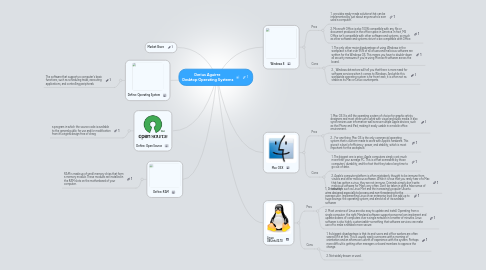
1. Define: Operating System
1.1. The software that supports a computer's basic functions, such as scheduling tasks, executing applications, and controlling peripherals
2. Define: Open Source
2.1. a program in which the source code is available to the general public for use and/or modification from its original design free of charg
3. Define: RAM
3.1. RAM is made up of small memory chips that form a memory module. These modules are installed in the RAM slots on the motherboard of your computer.
4. Market Share
5. Windows 8
5.1. Pros
5.1.1. 1. provides ready-made solutions that can be implemented by just about anyone who’s ever used a computer.
5.1.2. 2. Microsoft Office is also 100% compatible with any file or document produced in the office space in America. In fact, MS Office isn’t compatible with other software and systems, so much as other software and systems strive to be compatible with Office
5.2. Cons
5.2.1. 1. The only other major disadvantage of using Windows in the workplace is that over 95% of all viruses and malicious software are written for the Windows OS. This means you have to double-down all security measures if you’re using Microsoft software across the board.
5.2.2. 2. , Windows detractors will tell you that there is more need for software services when it comes to Windows. And while this worldwide operating system is far from trash, it is often not as stable as its Mac or Linux counterparts.
6. Mac OSX
6.1. Pros
6.1.1. 1. Mac OS X is still the operating system of choice for graphic artists, designers and most others who work with visual and audio media. It also synchronizes user information well across multiple Apple devices, such as the iPhone and iPad, making it easily usable in a mobile office environment.
6.1.2. 2. . For one thing, Mac OS is the only commercial operating system that is custom-made to work with Apple’s hardware. This gives it a level of efficiency, power, and stability, which is most important for the workplace.
6.2. Cons
6.2.1. 1. The biggest one is price: Apple computers simply cost much more than your average PC. This is offset somewhat by those computers’ durability, and the fact that they take a long time to go out of date.
6.2.2. 2. Apple’s computer platform is often mistakenly thought to be immune from viruses and other malicious software. While it is true that you rarely hear of a Mac that has gotten a virus, they are not immune. Criminals simply don’t write malicious software for Macs very often. Don’t be taken in with a false sense of security!
7. Linux UBUntu12.10
7.1. Pros
7.1.1. 1. Distributions such as Linux Mint and the increasingly popular Ubuntu were designed especially to be easy and non-threatening for the average user. Implementing Linux on an enterprise level can add up to huge savings: the operating system, and almost all of its available software
7.1.2. 2. Most versions of Linux are also easy to update and install. Operating from a single computer, the right Maryland software support personnel can implement and update dozens of computers over a single network in a matter of minutes. Linux software is also highly customizable–something that software services can make use of to make a network more secure
7.2. Cons
7.2.1. 1. Its biggest disadvantage is that its end-users and office workers are often scared of it at first. This is usually easily overcome with a morning of orientation and an afternoon’s worth of experience with the system. Perhaps more difficult is getting other managers or board members to approve the change.
7.2.2. 2. Not widely known or used.
